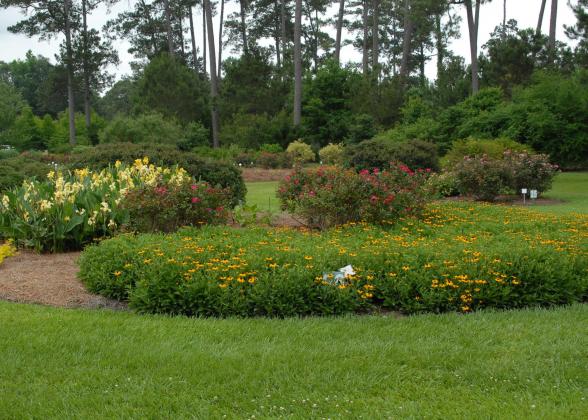
By Dan Gill
LSU AgCenter
Horticulturist
Gardeners are aware of the important relationship plants have with light. We are forever talking about the light preferences of plants. Every garden reference stresses how important it is to provide the proper light for different plants, indoors or outside. If a plant that needs a sunny location is planted in the shade, it will languish and do poorly.
Yet, I’m not sure gardeners really understand why light is so essential to plants — and why a sun-loving plant will do poorly if it does not get enough light. And for that I blame the term “plant food.”
Until the modern era, people really had no idea what plants ate. In ancient times, early farmers eventually realized that if they spread manure over a field before planting a crop, it made the plants grow better. It was easy for them to assume that plants grew better because they ate what was in the manure. The food provided by the manure made the plants grow better. But it was actually minerals in the manure, like nitrogen, that benefited the plants. So the idea that we are actually feeding plants when we add manure (or fertilizers) to the soil became entrenched, and it survives to this day. Am I right? Don’t we all say we “feed” our plants “plant food”?
The trouble is, now we know better. In the 20th century we discovered that plants carry out a remarkable chemical process called photosynthesis, meaning “to create from light.” And photosynthesis, as it turns out, is the basis of life as we know it.
In photosynthesis, plants absorb the energy of light with a green pigment called chlorophyll. This is generally from sunlight, but artificial light also works. The energy is used to combine carbon dioxide plants absorb from the air and water plants absorb from the soil to form molecules of sugar. Within the sugar molecules is stored the energy the plant absorbed from the sun, which we, in turn, use when we eat plants or animals that eat plants.
A byproduct of photosynthesis is oxygen, which plants release into the atmosphere. When photosynthetic bacteria and plants first evolved, there was very little oxygen in the atmosphere. Today, our atmosphere is rich in oxygen, and the world is full of animals that need oxygen to live. The photosynthetic process and the plants that initially carried it out literally transformed the world, allowing oxygen-breathing animals to exist.
Plants use the energy stored in the sugar created in photosynthesis and the carbon, hydrogen and oxygen that make up sugar, along with other elements they absorb from the soil, to build the tissue of their bodies and make everything they need to run their metabolisms. That’s right, the physical body of a plant — leaves, stems, roots, flowers and fruit — is literally created from carbon dioxide in the air and water.
So, plants do not eat the soil. Soil does not provide them the energy they need to live and grow. So why did early farmers find that plants grew better when manure was spread over the fields? Along with the water, plants’ roots also absorb various mineral elements from the soil. The minerals a plant absorbs from the soil only contribute a tiny fraction to its body, but they are critical to a plant’s health.
This is where fertilizers come in. They are not food. Indeed, it is physically impossible for us to actually feed or provide food to plants. We know now is that plants create their own food; we don’t have to “feed” them. What fertilizers do is provide some of the minerals, such as iron, nitrogen, magnesium, potassium and calcium, plants need to absorb from the soil to be healthy. If the soil doesn’t contain enough, adding these minerals makes plants grow better — just as we might take vitamins or mineral supplements. And you don’t consider the calcium, iron or potassium supplement you take as food.
Indeed, the better analogy for what fertilizers are and do for plants is to compare them to mineral supplements rather than food. It would much closer to what we are actually doing when we fertilize plants to say, “I need to give my plants some minerals,” rather than saying, “I need to feed my plants.” Only small amounts of fertilizers are needed, and people often put out more than necessary.
So the relationship plants have with light is not just about what levels plants prefer. Light is their energy source. It is what they consume to live. Plants are solar-powered organisms. Light is as important to the houseplant sitting on your windowsill or the live oak in your front yard as the food on your plate is to you each day.
If you provide a plant less than the amount of light it needs to be healthy, it will become weak and anemic, just as you would if you were deprived of most of the food you need to eat. Nothing else we can do — extra water, fertilizer or begging — will make a plant healthy if it is not getting enough light. Without sufficient light, there is no other way for the plant to create the food it needs, and it will slowly starve. Indoors, where light is especially limited, it is not unheard of for plants to literally starve to death while their owners worry about everything from watering to fertilizing.
I am probably not revealing anything earthshaking to you. We were all taught about photosynthesis in school at some time in our lives. But I think that gardeners often lose sight of what the relationship plants have with light is based on, so I thought I’d give you a little reminder. Keep in mind the importance of providing the proper light the next time you are wandering around your yard with a plant in your hand looking for someplace to plant it.
